The Pore Structure and Fractal Characteristics of Upper Paleozoic Coal-Bearing Shale Reservoirs in the Yangquan Block, Qinshui Basin
Abstract
1. Introduction
2. Materials and Methods
2.1. Materials
2.2. Organic Geochemistry Experiments
2.2.1. Total Organic Carbon (TOC) Analysis
2.2.2. Rock-Eval Pyrolysis
2.2.3. Vitrinite Reflectance Measurement
2.3. X-Ray Diffraction Analysis
2.4. Reservoir Pore Characterization Experiments
2.4.1. Scanning Electron Microscopy
2.4.2. Low-Pressure Gas Adsorption
2.4.3. High-Pressure Mercury Intrusion
2.5. Fractal Theory
3. Results
3.1. Organic Matter Characteristics
3.2. Mineral Composition
3.3. Pore Type Characteristics
3.4. Full-Scale Pore Size Distribution in Shale
3.4.1. High-Pressure Mercury Intrusion (HPMI)
3.4.2. Low-Temperature N2 Adsorption
3.4.3. Low-Pressure CO2 Adsorption
3.5. Fractal Characteristics of Shale
4. Discussion
4.1. Relationship Between Organic Matter Characteristics and Fractal Dimensions
4.2. Relationship Between Mineral Composition and Fractal Dimensions
4.3. Relationship Between Pore Structure and Fractal Dimensions
4.4. Implications for Shale Gas Exploration in the Upper Paleozoic Coal-Bearing Shale of the Yangquan Block, Qinshui Basin
5. Conclusions
- (1)
- The Upper Paleozoic coal-bearing shale in the Yangquan Block of the Qinshui Basin exhibits high organic matter abundance (TOC: avg. 3.82%) and has reached an overmature thermal maturity stage (Ro: avg. 2.29%). Mineralogically, it is characterized by a high clay mineral content (avg. 58.9% by mass) and a low brittle mineral content.
- (2)
- The Upper Paleozoic coal-bearing shale in the Yangquan Block of the Qinshui Basin exhibits low porosity and low permeability characteristics. Porosity ranges from 1.1 to 4.9% (average 3.1%), while permeability varies between 0.0008 × 10−3 and 0.1910 × 10−3 μm2 (average 0.0274 × 10−3 μm2). Pore types are dominated by interparticle pores, intraparticle pores, and microfractures, which collectively provide essential storage space for shale gas accumulation.
- (3)
- The Upper Paleozoic coal-bearing shale in the Yangquan Block of the Qinshui Basin exhibits a total pore volume ranging from 0.0255 to 0.8171 cm3/g (mean: 0.1157 cm3/g) and a total specific surface area (SSA) of 9.60–40.98 m2/g (mean: 19.43 m2/g). Micropores and mesopores demonstrate a strong positive correlation between their pore volumes and SSA, indicating that these pore types serve as the primary storage carriers for shale gas in the Yangquan Block. This micro-mesopore dominance suggests favorable shale gas storage potential. However, the limited fracability of the shale reservoir, likely due to the high clay mineral content and low brittle mineral proportions, poses significant challenges for gas extraction, potentially hindering commercial development.
- (4)
- The surface fractal dimension (D1) and volumetric fractal dimension (D2) quantify pore surface roughness and the filling capacity of nano-scale pore networks, respectively. A D1 value approaching 3 (e.g., 2.8–2.9) indicates well-developed organic pores or clay mineral interlayer fractures, signifying strong adsorption potential. D2→3 reflects complex structures formed by intertwined micropores and mesopores. D3 (50–1000 nm) characterizes the connectivity of mineral intergranular pores and microfractures, while D4 (1000–10,000 nm) delineates the spatial distribution of dissolution vugs and fracture networks. D5 (>10,000 nm) captures the roughness and seepage efficiency of macroscopic fractures. The segmented variations in fractal dimensions (e.g., D3 = 2.6 vs. D5 = 2.9) underscore the inherent heterogeneity of the “adsorption-seepage” contradiction in reservoirs, highlighting the dual challenges of balancing gas storage and flow capacity in coal-bearing shale systems.
- (5)
- The weak correlation (R2 < 0.2) between total organic carbon (TOC) and micropore fractal dimensions (D1 and D2) suggests that high thermal maturity (Ro > 2.0%) induces organic pore compaction, diminishing TOC’s contribution to pore complexity. Increasing Ro suppresses macropore fractal dimensions (D4 and D5 reduction) but may indirectly enhance micropore roughness (D3 weak positive correlation) through clay mineral transformations (e.g., illitization). High-quartz zones (>50%) exhibit uniform pore structures (D3 ≈ 2), favoring superior permeability but weak adsorption capacity. In contrast, high-clay zones (>60%) elevate micropore fractal dimensions (D1 and D2) while suppressing macropore connectivity (D4 and D5 decline). Optimal reservoirs require the synergistic combination of high D1 (>2.8) + low D4 (<2.6) + high D5 (>2.7), ensuring strong micropore adsorption, efficient macropore seepage, and complex fracture networks. This model balances adsorption–seepage trade-offs, offering a targeted framework for identifying high-potential intervals in heterogeneous, overmature coal-bearing shale systems.
Author Contributions
Funding
Data Availability Statement
Conflicts of Interest
References
- Dai, J.; Dong, D.; Ni, Y.; Gong, D.; Huang, S.; Hong, F.; Zhang, Y.; Liu, Q.; Wu, X.; Feng, Z. Distribution Patterns of Tight Sandstone Gas and Shale Gas. Pet. Explor. Dev. 2024, 51, 767–779. [Google Scholar] [CrossRef]
- Guo, X.; Wang, R.; Shen, B.; Wang, G.; Wan, C.; Wang, Q. Geological Characteristics, Resource Potential, and Development Direction of Shale Gas in China. Pet. Explor. Dev. 2025, 52, 17–32. [Google Scholar] [CrossRef]
- Li, S.; Zhou, Z.; Nie, H.; Zhang, L.; Song, T.; Liu, W.; Li, H.; Xu, Q.; Wei, S.; Tao, S. Distribution Characteristics, Exploration & Development, Geological Theories Research Progress and Exploration Directions of Shale Gas in China. China Geol. 2022, 5, 110–135. [Google Scholar] [CrossRef]
- Mcmahon, T.P.; Larson, T.E.; Zhang, T.; Shuster, M. Geologic Characteristics, Exploration and Production Progress of Shale Oil and Gas in the United States: An Overview. Pet. Explor. Dev. 2024, 51, 925–948. [Google Scholar] [CrossRef]
- Nie, H.; Dang, W.; Zhang, Q.; Zhang, J.; Li, P.; Zhang, S.; Ding, J.; Chen, Q.; Feng, Y.; Zhang, X. Evaluation of Gas Content in Organic-Rich Shale: A Review of the History, Current Status, and Future Directions. Geosci. Front. 2024, 15, 101921. [Google Scholar] [CrossRef]
- Zhai, G.; Wang, Y.; Zhou, Z.; Yu, S.; Chen, X.; Zhang, Y. Exploration and Research Progress of Shale Gas in China. China Geol. 2018, 1, 257–272. [Google Scholar] [CrossRef]
- Zhang, J.; Li, Z.; Wang, D.; Xu, L.; Li, Z.; Niu, J.; Chen, L.; Sun, Y.; Li, Q.; Yang, Z.; et al. Shale Gas Accumulation Patterns in China. Nat. Gas Ind. B 2023, 10, 14–31. [Google Scholar] [CrossRef]
- Zou, X.; Li, X.; Zhang, J.; Li, H.; Guo, M.; Zhao, P. Characteristics of Pore Structure and Gas Content of the Lower Paleozoic Shale from the Upper Yangtze Plate, South China. Energies 2021, 14, 7603. [Google Scholar] [CrossRef]
- Zou, C.; Dong, D.; Wang, Y.; Li, X.; Huang, J.; Wang, S.; Guan, Q.; Zhang, C.; Wang, H.; Liu, H.; et al. Shale Gas in China: Characteristics, Challenges and Prospects (II). Pet. Explor. Dev. 2016, 43, 182–196. [Google Scholar] [CrossRef]
- Miao, H.; Jiang, Z.X.; Gong, X.; Li, C.M.; Wang, D.D.; Wu, Q.Z. The shale gas migration capacity of the Qiongzhusi Formation: Implications for its enrichment model. Phys. Fluids 2025, 37, 056603. [Google Scholar] [CrossRef]
- He, X.; Chen, G.; Wu, J.; Liu, Y.; Wu, S.; Zhang, J.; Zhang, X. Deep Shale Gas Exploration and Development in the Southern Sichuan Basin: New Progress and Challenges. Nat. Gas Ind. B 2023, 10, 32–43. [Google Scholar] [CrossRef]
- Zhang, J.; Xiao, X.; Wang, J.; Lin, W.; Han, D.; Wang, C.; Li, Y.; Xiong, Y.; Zhang, X. Pore Structure and Fractal Characteristics of Coal-Bearing Cretaceous Nenjiang Shales from Songliao Basin, Northeast China. J. Nat. Gas Geosci. 2024, 9, 197–208. [Google Scholar] [CrossRef]
- Yun, L. Accumulation and Exploration Enlightenment of Shallow Normal-Pressure Shale Gas in Southeastern Sichuan Basin, SW China. Pet. Explor. Dev. 2023, 50, 1308–1319. [Google Scholar] [CrossRef]
- Yong, R.; Yang, H.; Wu, W.; Yang, X.; Yang, Y.; Huang, H. Controlling Factors and Exploration Potential of Shale Gas Enrichment and High Yield in Permian Dalong Formation, Northern Sichuan Basin, SW China. Pet. Explor. Dev. 2025, 52, 285–300. [Google Scholar] [CrossRef]
- Zhang, L.; He, X.; Li, X.; Li, K.; He, J.; Zhang, Z.; Guo, J.; Chen, Y.; Liu, W. Shale Gas Exploration and Development in the Sichuan Basin: Progress, Challenge and Countermeasures. Nat. Gas Ind. B 2022, 9, 176–186. [Google Scholar] [CrossRef]
- Zhao, Q.; Zhou, T.; Wang, H.; Jin, Y.; Zhou, S.; Duan, X. Determination of Adsorption Parameters in Shale Gas Resource/Reserve Calculation: Case Study of Wufeng Formation–Longmaxi Formation in the Sichuan Basin. Nat. Gas Ind. B 2023, 10, 304–311. [Google Scholar] [CrossRef]
- Lu, C.; Xiao, X.; Gai, H.; Feng, Y.; Li, G.; Meng, G.; Gao, P. Nanopore Structure Characteristics and Evolution of Type III Kerogen in Marine-Continental Transitional Shales from the Qinshui Basin, Northern China. Geoenergy Sci. Eng. 2023, 221, 211413. [Google Scholar] [CrossRef]
- Sun, J.; Xiao, X.; Cheng, P. Methane Absorption of Coal-Measure Shales with and without Pore Water from the Qinshui Basin, North China: Based on High-Pressure Methane Absorption Experiments. Int. J. Coal Geol. 2022, 263, 104116. [Google Scholar] [CrossRef]
- Yang, X.; Tang, S.; Xi, Z.; Zhang, S.; Zhang, Q.; Zhang, K.; Lin, D.; Wang, J. Dynamic Evolution and Differential Enrichment of Deep Coalbed Methane: A Case Study in Qinshui Basin. Int. J. Coal Geol. 2025, 299, 104696. [Google Scholar] [CrossRef]
- Zhang, X.; Li, X.; Yang, J.; Zhang, B.; Sun, J.; Yu, Z. Characterization of the Full-Sized Pore Structure and Controlling Factors of the Coal-Bearing Shale in the Wuxiang Block, South-Central Qinshui Basin, China. Front. Earth Sci. 2022, 9, 813925. [Google Scholar] [CrossRef]
- He, H.; Liu, P.; Xu, L.; Hao, S.; Qiu, X.; Shan, C.; Zhou, Y. Pore Structure Representations Based on Nitrogen Adsorption Experiments and an FHH Fractal Model: Case Study of the Block Z Shales in the Ordos Basin, China. J. Pet. Sci. Eng. 2021, 203, 108661. [Google Scholar] [CrossRef]
- He, T.; Zhou, Y.; Chen, Z.; Zhang, Z.; Xie, H.; Shang, Y.; Cui, G. Fractal Characterization of the Pore-Throat Structure in Tight Sandstone Based on Low-Temperature Nitrogen Gas Adsorption and High-Pressure Mercury Injection. Fractal Fract. 2024, 8, 356. [Google Scholar] [CrossRef]
- Ma, X.; Guo, S.; Shi, D.; Zhou, Z.; Liu, G. Investigation of Pore Structure and Fractal Characteristics of Marine-Continental Transitional Shales from Longtan Formation Using MICP, Gas Adsorption, and NMR (Guizhou, China). Mar. Pet. Geol. 2019, 107, 555–571. [Google Scholar] [CrossRef]
- Ning, S.; Xia, P.; Hao, F.; Tian, J.; Fu, Y.; Wang, K. Pore Fractal Characteristics between Marine and Marine–Continental Transitional Black Shales: A Case Study of Niutitang Formation and Longtan Formation. Fractal Fract. 2024, 8, 288. [Google Scholar] [CrossRef]
- Wang, Y.; Han, D.; Lin, W.; Jia, Y.; Zhang, J.; Wang, C.; Ma, B. Factors Controlling Differences in Morphology and Fractal Characteristics of Organic Pores of Longmaxi Shale in Southern Sichuan Basin, China. Fractal Fract. 2024, 8, 555. [Google Scholar] [CrossRef]
- Mandelbrot, B.B. Les Objets Fractals: Forme, Hazard et Dimension; Flammarion: Paris, France, 1975. [Google Scholar]
- Zhang, J.; Li, X.; Wei, Q.; Sun, K.; Zhang, G.; Wang, F. Characterization of Full-Sized Pore Structure and Fractal Characteristics of Marine–Continental Transitional Longtan Formation Shale of Sichuan Basin, South China. Energy Fuels 2017, 31, 10490–10504. [Google Scholar] [CrossRef]
- Feng, Y.; Xiao, X.-M.; Wang, E.-Z.; Gao, P.; Lu, C.-G.; Li, G. Gas Storage in Shale Pore System: A Review of the Mechanism, Control and Assessment. Pet. Sci. 2023, 20, 2605–2636. [Google Scholar] [CrossRef]
- Li, X.; Li, Y.; Li, J.; Zou, X.; Guo, M.; Wang, Z.; Zhang, X.; Wang, F. Characteristics of Pore Structures from the Lower Paleozoic Shale Gas Reservoirs in Northern Guizhou, South China. J. Nat. Gas Geosci. 2020, 5, 241–253. [Google Scholar] [CrossRef]
- Liu, Z.; Zhao, S.; Hu, Z.; Shen, B.; Feng, D.; Zhang, J.; Ye, J.; Ma, C.; Dong, Z. Characteristics and Controlling Factors of Coal-Measure Unconventional Reservoirs—A Case Study of the Carboniferous-Permian in the Ordos Basin. Unconv. Resour. 2025, 6, 100153. [Google Scholar] [CrossRef]
- Nie, H.; Jin, Z.; Li, P.; Jay Katz, B.; Dang, W.; Liu, Q.; Ding, J.; Jiang, S.; Li, D. Deep Shale Gas in the Ordovician-Silurian Wufeng–Longmaxi Formations of the Sichuan Basin, SW China: Insights from Reservoir Characteristics, Preservation Conditions and Development Strategies. J. Asian Earth Sci. 2023, 244, 105521. [Google Scholar] [CrossRef]
- Zhang, M.; Fu, X. Influence of Reservoir Properties on the Adsorption Capacity and Fractal Features of Shales from Qinshui Coalfield. J. Pet. Sci. Eng. 2019, 177, 650–662. [Google Scholar] [CrossRef]
- Wang, Q.; Lu, H.; Wang, T.; Liu, D.; Peng, P.; Zhan, X.; Li, X. Pore Characterization of Lower Silurian Shale Gas Reservoirs in the Middle Yangtze Region, Central China. Mar. Pet. Geol. 2018, 89, 14–26. [Google Scholar] [CrossRef]
- Liang, J.; Huang, W.; Wang, H.; Blum, M.J.; Chen, J.; Wei, X.; Yang, G. Organic Geochemical and Petrophysical Characteristics of Transitional Coal-Measure Shale Gas Reservoirs and Their Relationships with Sedimentary Environments: A Case Study from the Carboniferous-Permian Qinshui Basin, China. J. Pet. Sci. Eng. 2020, 184, 106510. [Google Scholar] [CrossRef]
- Xiang, J.; Li, J.; Li, X.; Ma, X.; Sun, J.; Zou, Z.; Qin, Y. Isotopic and Hydrochemical Evidence for the Origins of Unconventional Gases in the Middle and Lower Jurassic Coal Measures in the Fukang Area of Junggar Basin, NW China. Int. J. Coal Geol. 2025, 302, 104726. [Google Scholar] [CrossRef]
- Meng, Z.; Zhang, J.; Wang, R. In-Situ Stress, Pore Pressure and Stress-Dependent Permeability in the Southern Qinshui Basin. Int. J. Rock Mech. Min. Sci. 2011, 48, 122–131. [Google Scholar] [CrossRef]
- Li, J.; Tang, S.; Zhang, S.; Li, L.; Wei, J.; Xi, Z.; Sun, K. Characterization of Unconventional Reservoirs and Continuous Accumulations of Natural Gas in the Carboniferous-Permian Strata, Mid-Eastern Qinshui Basin, China. J. Nat. Gas Sci. Eng. 2018, 49, 298–316. [Google Scholar] [CrossRef]
- Zhang, M.; Fu, X.; Zhang, Q.; Cheng, W. Research on the Organic Geochemical and Mineral Composition Properties and Its Influence on Pore Structure of Coal-Measure Shales in Yushe-Wuxiang Block, South Central Qinshui Basin, China. J. Pet. Sci. Eng. 2019, 173, 1065–1079. [Google Scholar] [CrossRef]
- Peng, C.; Zou, C.; Yang, Y.; Zhang, G.; Wang, W. Fractal Analysis of High Rank Coal from Southeast Qinshui Basin by Using Gas Adsorption and Mercury Porosimetry. J. Pet. Sci. Eng. 2017, 156, 235–249. [Google Scholar] [CrossRef]
- Zhang, J.; Li, X.; Xiaoyan, Z.; Zhao, G.; Zhou, B.; Li, J.; Xie, Z.; Wang, F. Characterization of the Full-Sized Pore Structure of Coal-Bearing Shales and Its Effect on Shale Gas Content. Energy Fuels 2019, 33, 1969–1982. [Google Scholar] [CrossRef]
- Ge, T.; Pan, J.; Wang, K.; Liu, W.; Mou, P.; Wang, X. Heterogeneity of Pore Structure of Late Paleozoic Transitional Facies Coal-Bearing Shale in the Southern North China and Its Main Controlling Factors. Mar. Pet. Geol. 2020, 122, 104710. [Google Scholar] [CrossRef]
- Zhang, Q.; Jin, Z.; Deng, E.; Xu, Z.; Zhu, R.; Liu, Q.; Yan, Z.; Hu, K.; Zheng, T.; Hu, Z. Accumulation and Maturation of Organic Matter in Shales: The Coal-Bearing Permian Longtan Formation at Tucheng Syncline, Southwestern Guizhou, China. Appl. Geochem. 2025, 180, 106257. [Google Scholar] [CrossRef]
- Shao, L.-Y.; Yang, Z.-Y.; Shang, X.-X.; Xiao, Z.-H.; Wang, S.; Zhang, W.-L.; Zheng, M.-Q.; Lu, J. Lithofacies Palaeogeography of the Carboniferous and Permian in the Qinshui Basin, Shanxi Province, China. J. Palaeogeogr. 2015, 4, 384–412. [Google Scholar] [CrossRef]
- GB/T 19145-2003; Determination of Total Organic Carbon in Sedimentary Rock. Standardization Administration of China (SAC): Beijing, China, 2003.
- GB/T 18602-2012; Rock Pyrolysis Analysis. Standardization Administration of China (SAC): Beijing, China, 2012.
- SY/T 5124-2012; Microscopy Identification Method of Macerals in Sedimentary Rocks. National Energy Administration (NEA) of China: Beijing, China, 2012.
- SY/T 5163-2018; Analytical Method of Rock Samples by Scanning Electron Microscopy. National Energy Administration (NEA) of China: Beijing, China, 2018.
- SY/T 5162-2014; Analysis Method for Clay Minerals and Common Non-Clay Minerals in Sedimentary Rocks by X-Ray Diffraction. National Energy Administration (NEA) of China: Beijing, China, 2014.
- GB/T 19587-2017; Determination of the Specific Surface Area of Solids by Gas Adsorption Using the BET Method. Standardization Administration of China (SAC): Beijing, China, 2017.
- GB/T 21650.1-2008; Pore Size Distribution and Porosity of Solid Materials by Mercury Porosimetry and Gas Adsorption—Part 1: Mercury Porosimetry. Standardization Administration of China (SAC): Beijing, China, 2008.
- ISO 15901-1:2005; Pore Size Distribution and Porosity of Solid Materials by Mercury Porosimetry and Gas Adsorption—Part 1: Mercury Porosimetry. International Organization for Standardization (ISO): Geneva, Switzerland, 2005.
- Mahamud, M.M.; Novo, M.F. The Use of Fractal Analysis in the Textural Characterization of Coals. Fuel 2008, 87, 222–231. [Google Scholar] [CrossRef]
- Peter, P.; Avnir, D. Chemistry in noninteger dimensions between two and three. J. Chem. Phys. 1983, 79, 3558–3565. [Google Scholar] [CrossRef] [PubMed]
- Avnir, D.; Jaroniec, M. An Isotherm Equation for Adsorption on Fractal Surfaces of Heterogeneous Porous Materials. Langmuir 1989, 5, 1431–1433. [Google Scholar] [CrossRef]
- Pfeifer, P. Fractal dimension as working tool for surface-roughness problems. Appl. Surf. Sci. 1984, 18, 146–164. [Google Scholar] [CrossRef]
- Tatlıer, M.; Erdem-Şenatalar, A. Method to evaluate the fractal dimensions of solid adsorbents. J. Phys. Chem. 1999, 103, 4360–4365. [Google Scholar] [CrossRef]
- Yao, Y.; Liu, D.; Tang, D.; Tang, S.; Huang, W. Fractal characterization of adsorption-Pores of coals from North China: An investigation on CH4 adsorption capacity of coals. Int. J. Coal Geol. 2008, 73, 27–42. [Google Scholar] [CrossRef]
- Loucks, R.G.; Reed, R.M.; Ruppel, S.C.; Hammes, U. Spectrum of pore types and networks in mudrocks and a descriptive classification for matrix-related mudrock pores. AAPG Bull. 2012, 96, 1071–1098. [Google Scholar] [CrossRef]
- Reed, R.M.; Loucks, R.L. Imaging nanoscale pores in the Mississippian Barnett Shale of the northern Fort Worth Basin. AAPG Annu. Conv. Abstr. 2007, 16, 115. [Google Scholar]
- Bustin, R.M.; Bustin, A.; Cui, A.; Ross, D.; Pathi, V.M. Impact of Shale Properties on Pore Structure and Storage Characteristics. Presented at the SPE Shale Gas Production Conference, Fort Worth, TX, USA, 16–18 November 2008. [Google Scholar] [CrossRef]
- Montgomery, S.L.; Jarvie, D.M.; Bowker, K.A.; Pollastro, R.M. Mississippian Barnett Shale, Fort Worth basin, north-central Texas: Gas-shale play with multi–trillion cubic foot potential. AAPG Bull. 2005, 89, 155–175. [Google Scholar] [CrossRef]
- Jarvie, D.M.; Hill, R.J.; Ruble, T.E.; Pollastro, R.M. Unconventional shale-gas systems: The Mississippian Barnett Shale of north-central Texas as one model for thermogenic shale-gas assessment. AAPG Bull. 2007, 91, 475–499. [Google Scholar] [CrossRef]
- Bowker, K.A. Barnett Shale gas production, Fort Worth Basin: Issues and discussion. AAPG Bull. 2007, 91, 523–533. [Google Scholar] [CrossRef]
- Zhang, J.; Li, X.; Wei, Q.; Gao, W.; Liang, W.; Wang, Z.; Wang, F. Quantitative Characterization of Pore-Fracture System of Organic-Rich Marine-Continental Shale Reservoirs: A Case Study of the Upper Permian Longtan Formation, Southern Sichuan Basin, China. Fuel 2017, 200, 272–281. [Google Scholar] [CrossRef]
- Rowe, H.D.; Loucks, R.G.; Ruppel, S.C.; Rimmer, S.M. Mississippian Barnett Formation, Fort Worth Basin, Texas: Bulk Geochemical Inferences and Mo–TOC Constraints on the Severity of Hydrographic Restriction. Chem. Geol. 2008, 257, 16–25. [Google Scholar] [CrossRef]
- Hu, J.; Tang, S.; Zhang, S. Investigation of Pore Structure and Fractal Characteristics of the Lower Silurian Longmaxi Shales in Western Hunan and Hubei Provinces in China. J. Nat. Gas Sci. Eng. 2016, 28, 522–535. [Google Scholar] [CrossRef]
- IUPAC. Reporting physisorption data for gas/solid systems with special reference to the determination of surface area and porosity. Pure Appl. Chem. 1982, 54, 2201–2218. [Google Scholar] [CrossRef]
- Broekhoff, J.C.P.; Boer, J.H. Studies on pore systems in catalysts XIII: Pore distributions from the desorption branch of a nitrogen sorption isotherm in the case of cylindrical pores: B applications. J. Catal. 1968, 10, 377–390. [Google Scholar] [CrossRef]
- Rouquerol, J.; Avnir, D.; Fairbridge, C.W.; Everett, D.H.; Haynes, J.M.; Pernicone, N.; Ramsay, J.D.F.; Sing, K.S.W.; Unger, K.K. Recommendations for the characterization of porous solids (Technical Report). Pure Appl. Chem. 1994, 66, 1739–1758. [Google Scholar] [CrossRef]
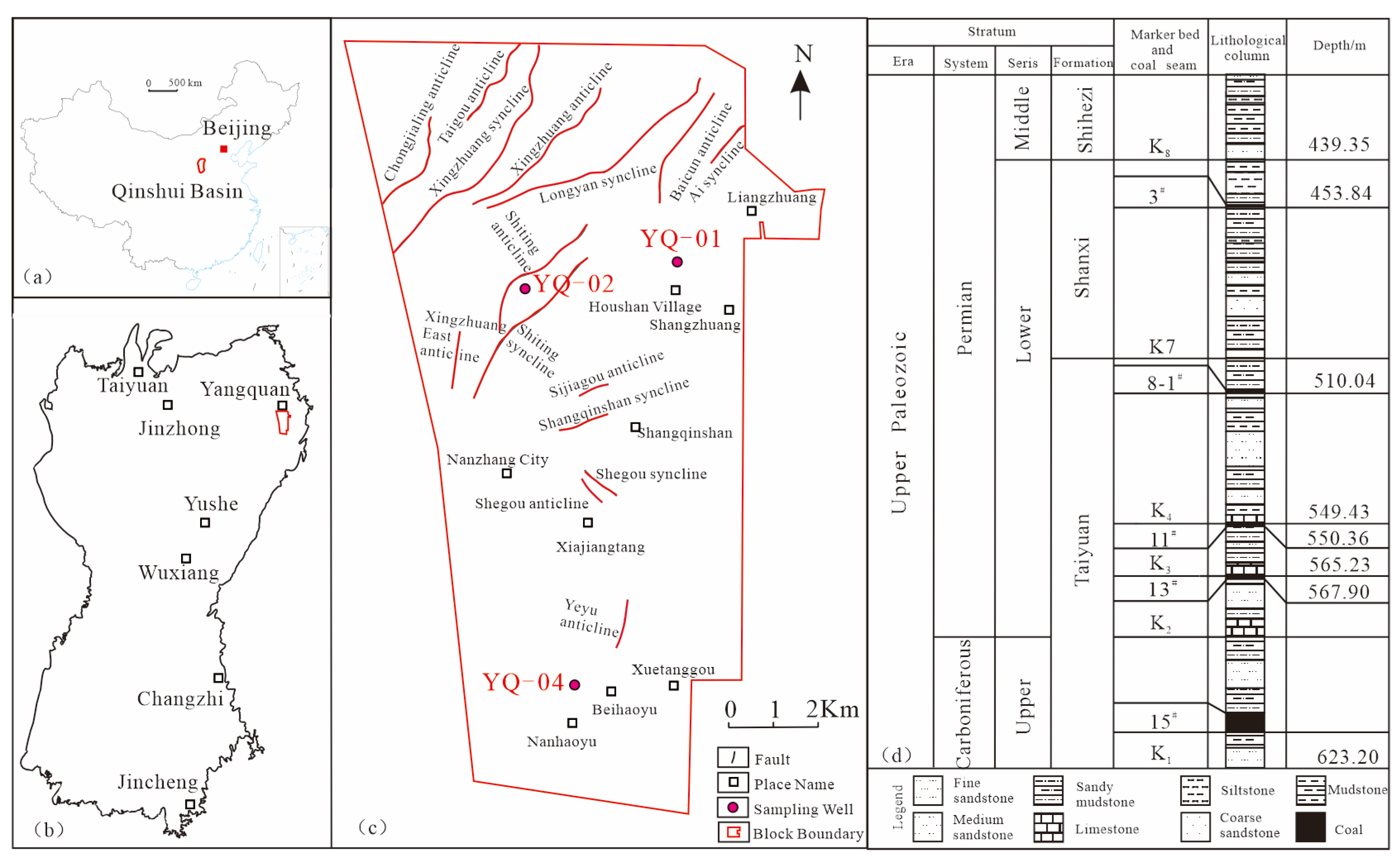
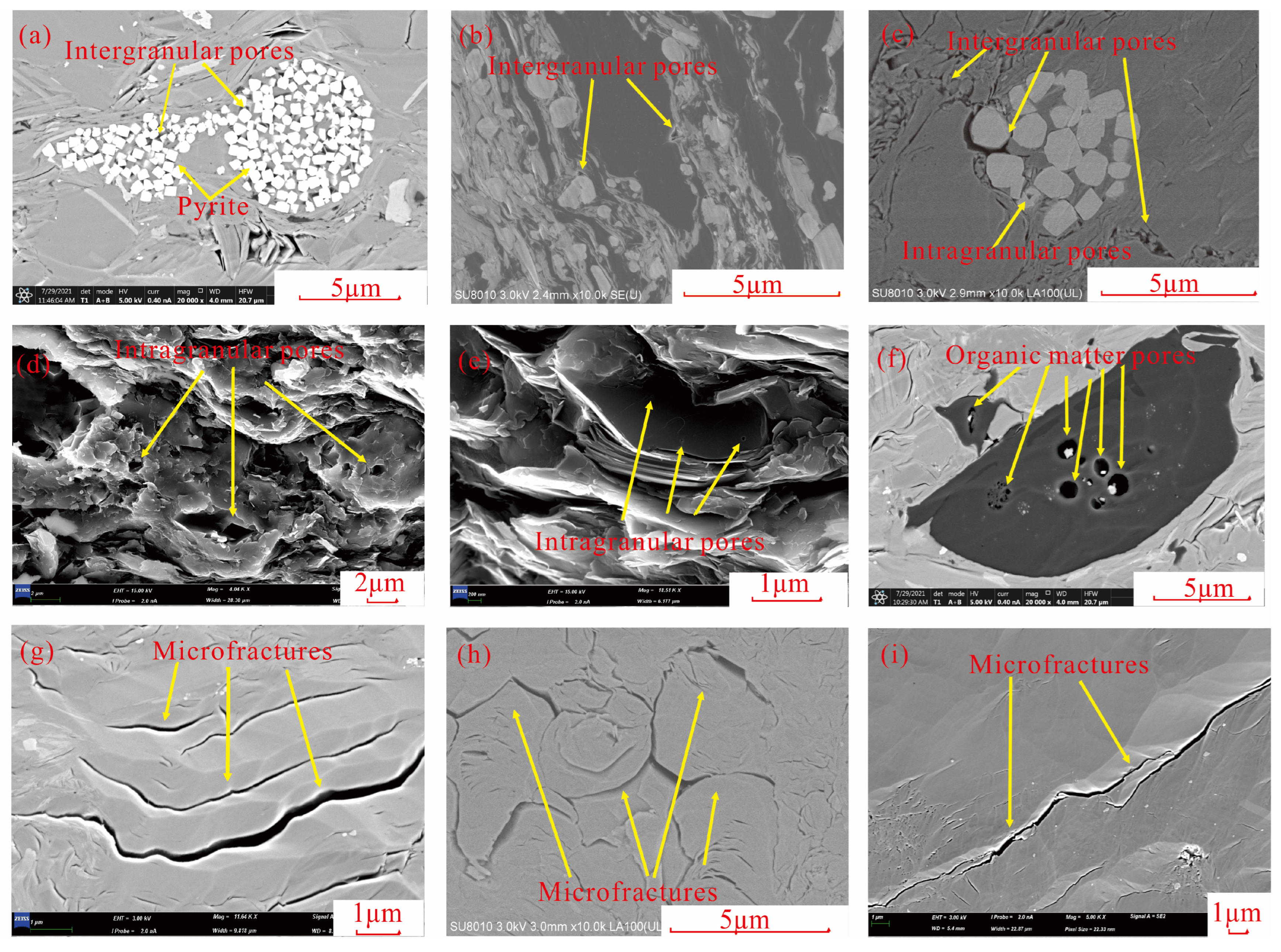

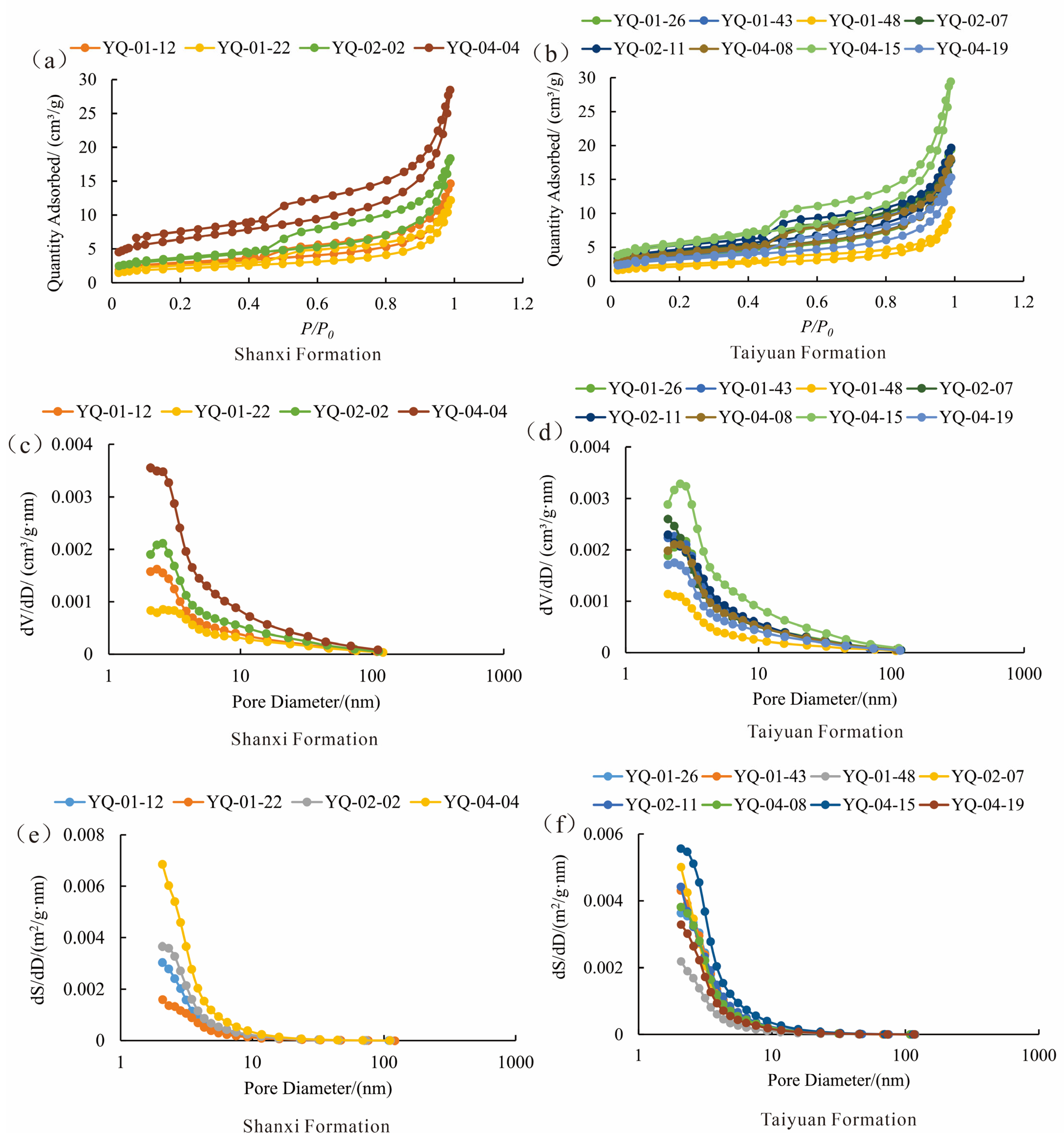


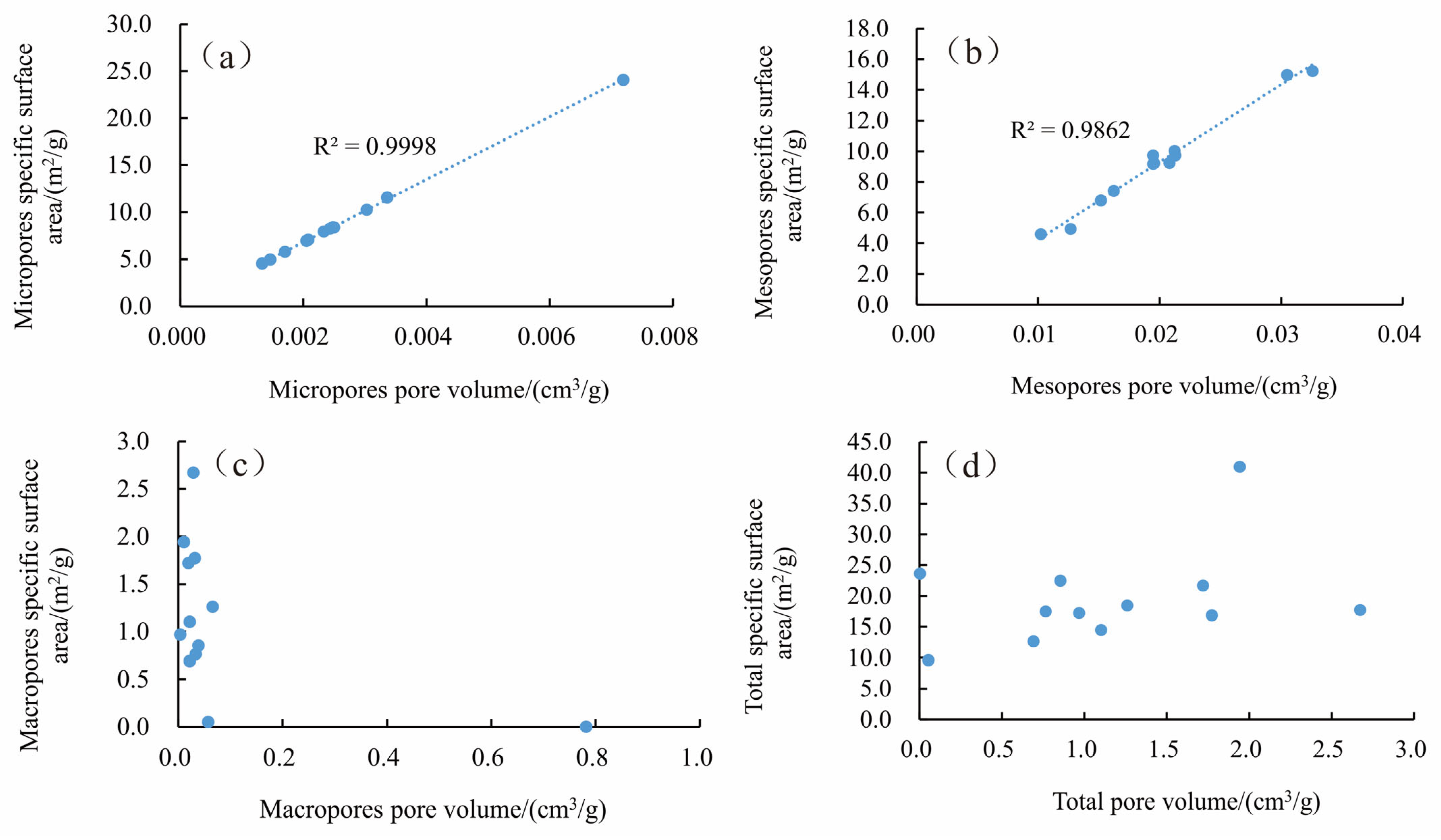




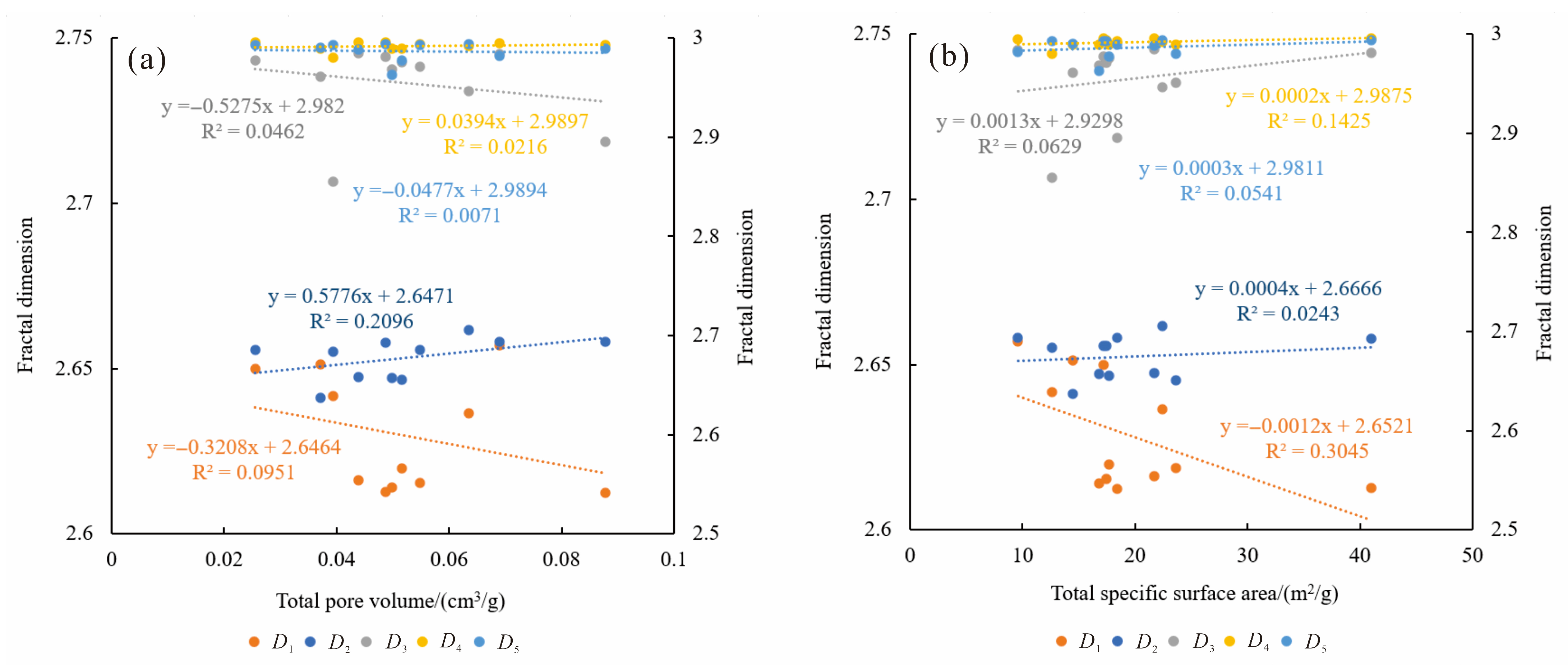
| Sample | Depth (m) | Formation | Lithology | TOC (%) | Ro (%) | Tmax (°C) | S1 + S2 (mg/g) |
|---|---|---|---|---|---|---|---|
| YQ-01-12 | 308.2 | Shanxi | Grayish black mudstone | 3.29 | 2.16 | 550 | 0.42 |
| YQ-01-22 | 350.7 | Shanxi | Black mudstone | 4.63 | 2.13 | 545 | 0.12 |
| YQ-01-26 | 379.6 | Taiyuan | Grayish black mudstone | 5.11 | 2.24 | 549 | 0.48 |
| YQ-01-43 | 461.4 | Taiyuan | Black mudstone | 2.47 | - | 558 | 0.07 |
| YQ-01-48 | 477.3 | Taiyuan | Black mudstone | 1.75 | - | 546 | 0.18 |
| YQ-02-02 | 383.7 | Shanxi | Black mudstone | 1.97 | 2.22 | 543 | 0.22 |
| YQ-02-07 | 409.6 | Taiyuan | Black mudstone | 2.67 | 2.29 | 564 | 0.21 |
| YQ-02-11 | 466.5 | Taiyuan | Black mudstone | 3.63 | 2.56 | 541 | 0.16 |
| YQ-04-04 | 452.6 | Shanxi | Carbonaceous mudstone | 14.73 | 2.28 | 551 | 3.49 |
| YQ-04-08 | 485.5 | Taiyuan | Black mudstone | 2.11 | - | 554 | 0.29 |
| YQ-04-15 | 517.3 | Taiyuan | Carbonaceous mudstone | 2.48 | 2.4 | 564 | 0.56 |
| YQ-04-19 | 557.2 | Taiyuan | Black silty mudstone | 0.98 | - | 574 | 0.19 |
| Sample | Mineral Composition (%) | ||||||||
|---|---|---|---|---|---|---|---|---|---|
| Quartz | Potassium Feldspar | Plagioclase | Calcite | Dolomite | Siderite | Pyrite | Ankerite | Clay Minerals | |
| YQ-01-12 | 26.2 | 0 | 0 | 0 | 0 | 0 | 2.4 | 0 | 71.4 |
| YQ-01-22 | 20.9 | 0 | 1.3 | 0 | 0 | 2.9 | 0 | 0 | 74.9 |
| YQ-01-26 | 31 | 0 | 1.3 | 0 | 0 | 1.1 | 0 | 0 | 66.6 |
| YQ-01-43 | 2.2 | 0 | 0 | 0 | 0 | 0 | 0 | 0 | 97.8 |
| YQ-01-48 | 41.8 | 1 | 2.1 | 0 | 0 | 8 | 1.3 | 0 | 45.8 |
| YQ-02-02 | 38.6 | 0 | 0 | 0 | 0 | 5.3 | 3.2 | 0 | 52.9 |
| YQ-02-07 | 26.6 | 0 | 1.4 | 0 | 0 | 0 | 1.1 | 0 | 70.9 |
| YQ-02-11 | 31.5 | 0 | 1.3 | 0 | 0 | 0 | 1.5 | 0 | 65.7 |
| YQ-04-04 | 33.5 | 3.9 | 0 | 1.4 | 0 | 0 | 0 | 0 | 61.2 |
| YQ-04-08 | 60.0 | 0 | 3.6 | 1.3 | 0 | 0 | 6.3 | 0 | 28.8 |
| YQ-04-15 | 50.1 | 0 | 0 | 1.7 | 0 | 0 | 1.9 | 0 | 46.3 |
| YQ-04-19 | 36.4 | 2.4 | 0 | 1.0 | 19 | 1.6 | 1.8 | 13.9 | 23.9 |
| Sample | Pore Volume/(cm3/g) | Specific Surface Area/(m2/g) | ||||||
|---|---|---|---|---|---|---|---|---|
| Micropores | Mesopores | Macropores | Total Pore Volume | Micropores | Mesopores | Macropores | Total Specific Surface Area | |
| YQ-01-12 | 0.0024 | 0.0152 | 0.0322 | 0.0498 | 8.261 | 6.800 | 1.773 | 16.834 |
| YQ-01-22 | 0.0025 | 0.0127 | 0.0220 | 0.0371 | 8.417 | 4.943 | 1.102 | 14.462 |
| YQ-01-26 | 0.0030 | 0.0213 | 0.0196 | 0.0439 | 10.259 | 9.728 | 1.719 | 21.706 |
| YQ-01-43 | 0.0021 | 0.0195 | 0.0333 | 0.0548 | 6.955 | 9.729 | 0.764 | 17.448 |
| YQ-01-48 | 0.0015 | 0.0102 | 0.0573 | 0.0690 | 4.950 | 4.598 | 0.053 | 9.601 |
| YQ-02-02 | 0.0017 | 0.0208 | 0.0291 | 0.0516 | 5.792 | 9.241 | 2.672 | 17.705 |
| YQ-02-07 | 0.0023 | 0.0195 | 0.0660 | 0.0879 | 7.948 | 9.227 | 1.260 | 18.435 |
| YQ-02-11 | 0.0034 | 0.0212 | 0.0390 | 0.0636 | 11.578 | 10.026 | 0.854 | 22.458 |
| YQ-04-04 | 0.0072 | 0.0305 | 0.0111 | 0.0488 | 24.060 | 14.978 | 1.943 | 40.981 |
| YQ-04-08 | 0.0021 | 0.0195 | 0.0040 | 0.0255 | 7.082 | 9.175 | 0.967 | 17.224 |
| YQ-04-15 | 0.0025 | 0.0326 | 0.7820 | 0.8171 | 8.402 | 15.225 | 0.002 | 23.629 |
| YQ-04-19 | 0.0013 | 0.0162 | 0.0219 | 0.0395 | 4.535 | 7.413 | 0.691 | 12.639 |
| Sample | D1 | R2 | D2 | R2 | D3 | R2 | D4 | R2 | D5 | R2 |
|---|---|---|---|---|---|---|---|---|---|---|
| YQ-01-12 | 2.6141 | 0.9996 | 2.6570 | 0.9987 | 2.9682 | 0.9814 | 2.9891 | 0.9556 | 2.9629 | 0.8977 |
| YQ-01-22 | 2.6512 | 0.9965 | 2.6371 | 0.9978 | 2.9612 | 0.9477 | 2.9897 | 0.9263 | 2.9901 | 0.9655 |
| YQ-01-26 | 2.6163 | 0.9995 | 2.6583 | 0.9983 | 2.9852 | 0.9888 | 2.9956 | 0.9748 | 2.9885 | 0.9408 |
| YQ-01-43 | 2.6154 | 0.9991 | 2.6852 | 0.9967 | 2.9707 | 0.9638 | 2.994 | 0.9657 | 2.9932 | 0.9754 |
| YQ-01-48 | 2.6569 | 0.9980 | 2.6934 | 0.9989 | 2.9834 | 0.9802 | 2.9944 | 0.9556 | 2.9816 | 0.9024 |
| YQ-02-02 | 2.6198 | 0.9998 | 2.6558 | 0.9983 | 2.9760 | 0.9880 | 2.9891 | 0.9543 | 2.9774 | 0.9659 |
| YQ-02-07 | 2.6123 | 0.9987 | 2.6938 | 0.9989 | 2.8955 | 0.6979 | 2.9928 | 0.9916 | 2.9897 | 0.9600 |
| YQ-02-11 | 2.6365 | 0.9908 | 2.7054 | 0.9982 | 2.9465 | 0.8104 | 2.9923 | 0.9706 | 2.9942 | 0.9962 |
| YQ-04-04 | 2.6127 | 0.9943 | 2.6924 | 0.9989 | 2.9812 | 0.7915 | 2.9958 | 0.9628 | 2.9935 | 0.9260 |
| YQ-04-08 | 2.6498 | 0.9989 | 2.6858 | 0.9989 | 2.9777 | 0.9701 | 2.9961 | 0.7884 | 2.9926 | 0.9481 |
| YQ-04-15 | 2.6186 | 0.9998 | 2.6511 | 0.9979 | 2.9508 | 0.9927 | 2.9893 | 0.7504 | 2.9805 | 0.9650 |
| YQ-04-19 | 2.6416 | 0.9992 | 2.6838 | 0.9988 | 2.8555 | 0.9171 | 2.9806 | 0.6503 | 2.9928 | 0.9688 |
Disclaimer/Publisher’s Note: The statements, opinions and data contained in all publications are solely those of the individual author(s) and contributor(s) and not of MDPI and/or the editor(s). MDPI and/or the editor(s) disclaim responsibility for any injury to people or property resulting from any ideas, methods, instructions or products referred to in the content. |
© 2025 by the authors. Licensee MDPI, Basel, Switzerland. This article is an open access article distributed under the terms and conditions of the Creative Commons Attribution (CC BY) license (https://creativecommons.org/licenses/by/4.0/).
Share and Cite
Zhang, J.; Li, X.; Zhang, X.; Zou, X.; Yang, Y.; Kang, S. The Pore Structure and Fractal Characteristics of Upper Paleozoic Coal-Bearing Shale Reservoirs in the Yangquan Block, Qinshui Basin. Fractal Fract. 2025, 9, 467. https://doi.org/10.3390/fractalfract9070467
Zhang J, Li X, Zhang X, Zou X, Yang Y, Kang S. The Pore Structure and Fractal Characteristics of Upper Paleozoic Coal-Bearing Shale Reservoirs in the Yangquan Block, Qinshui Basin. Fractal and Fractional. 2025; 9(7):467. https://doi.org/10.3390/fractalfract9070467
Chicago/Turabian StyleZhang, Jinqing, Xianqing Li, Xueqing Zhang, Xiaoyan Zou, Yunfeng Yang, and Shujuan Kang. 2025. "The Pore Structure and Fractal Characteristics of Upper Paleozoic Coal-Bearing Shale Reservoirs in the Yangquan Block, Qinshui Basin" Fractal and Fractional 9, no. 7: 467. https://doi.org/10.3390/fractalfract9070467
APA StyleZhang, J., Li, X., Zhang, X., Zou, X., Yang, Y., & Kang, S. (2025). The Pore Structure and Fractal Characteristics of Upper Paleozoic Coal-Bearing Shale Reservoirs in the Yangquan Block, Qinshui Basin. Fractal and Fractional, 9(7), 467. https://doi.org/10.3390/fractalfract9070467






